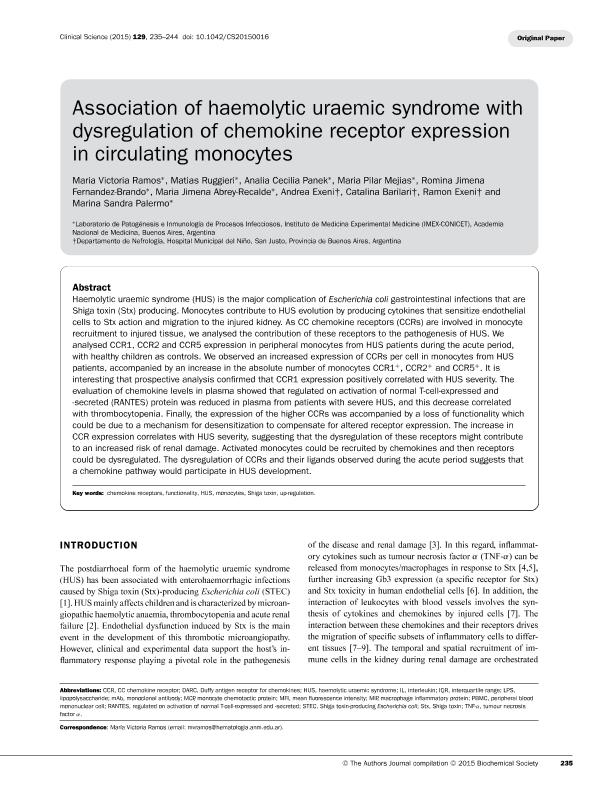Mostrar el registro sencillo del ítem
dc.contributor.author
Ramos, Maria Victoria

dc.contributor.author
Ruggieri, Matias

dc.contributor.author
Panek, Cecilia Analía

dc.contributor.author
Mejias, María Pilar

dc.contributor.author
Fernández Brando, Romina Jimena

dc.contributor.author
Abrey Recalde, Maria Jimena

dc.contributor.author
Exeni, Andrea
dc.contributor.author
Barilari, Catalina
dc.contributor.author
Exeni, Ramon
dc.contributor.author
Palermo, Marina Sandra

dc.date.available
2019-09-27T01:10:40Z
dc.date.issued
2015-08
dc.identifier.citation
Ramos, Maria Victoria; Ruggieri, Matias; Panek, Cecilia Analía; Mejias, María Pilar; Fernández Brando, Romina Jimena; et al.; Association of haemolytic uraemic syndrome with dysregulation of chemokine receptor expression in circulating monocytes; Portland Press; Clinical Science; 129; 3; 8-2015; 235-244
dc.identifier.issn
0143-5221
dc.identifier.uri
http://hdl.handle.net/11336/84646
dc.description.abstract
Haemolytic uraemic syndrome (HUS) is the major complication of Escherichia coli gastrointestinal infections that are Shiga toxin (Stx) producing. Monocytes contribute to HUS evolution by producing cytokines that sensitize endothelial cells to Stx action and migration to the injured kidney. As CC chemokine receptors (CCRs) are involved in monocyte recruitment to injured tissue, we analysed the contribution of these receptors to the pathogenesis of HUS. We analysed CCR1, CCR2 and CCR5 expression in peripheral monocytes from HUS patients during the acute period, with healthy children as controls. We observed an increased expression of CCRs per cell in monocytes from HUS patients, accompanied by an increase in the absolute number of monocytes CCR1+, CCR2+ and CCR5+. It is interesting that prospective analysis confirmed that CCR1 expression positively correlated with HUS severity. The evaluation of chemokine levels in plasma showed that regulated on activation of normal T-cell-expressed and -secreted (RANTES) protein was reduced in plasma from patients with severe HUS, and this decrease correlated with thrombocytopenia. Finally, the expression of the higher CCRs was accompanied by a loss of functionality which could be due to a mechanism for desensitization to compensate for altered receptor expression. The increase in CCR expression correlates with HUS severity, suggesting that the dysregulation of these receptors might contribute to an increased risk of renal damage. Activated monocytes could be recruited by chemokines and then receptors could be dysregulated. The dysregulation of CCRs and their ligands observed during the acute period suggests that a chemokine pathway would participate in HUS development.
dc.format
application/pdf
dc.language.iso
eng
dc.publisher
Portland Press

dc.rights
info:eu-repo/semantics/openAccess
dc.rights.uri
https://creativecommons.org/licenses/by-nc-sa/2.5/ar/
dc.subject
CHEMOKINE RECEPTORS
dc.subject
FUNCTIONALITY
dc.subject
HUS
dc.subject
MONOCYTES
dc.subject
SHIGA TOXIN
dc.subject
UP-REGULATION
dc.subject.classification
Bioquímica y Biología Molecular

dc.subject.classification
Ciencias Biológicas

dc.subject.classification
CIENCIAS NATURALES Y EXACTAS

dc.title
Association of haemolytic uraemic syndrome with dysregulation of chemokine receptor expression in circulating monocytes
dc.type
info:eu-repo/semantics/article
dc.type
info:ar-repo/semantics/artículo
dc.type
info:eu-repo/semantics/publishedVersion
dc.date.updated
2019-09-20T14:15:30Z
dc.journal.volume
129
dc.journal.number
3
dc.journal.pagination
235-244
dc.journal.pais
Reino Unido

dc.journal.ciudad
Londres
dc.description.fil
Fil: Ramos, Maria Victoria. Consejo Nacional de Investigaciones Científicas y Técnicas. Instituto de Medicina Experimental. Academia Nacional de Medicina de Buenos Aires. Instituto de Medicina Experimental; Argentina
dc.description.fil
Fil: Ruggieri, Matias. Consejo Nacional de Investigaciones Científicas y Técnicas. Instituto de Medicina Experimental. Academia Nacional de Medicina de Buenos Aires. Instituto de Medicina Experimental; Argentina
dc.description.fil
Fil: Panek, Cecilia Analía. Consejo Nacional de Investigaciones Científicas y Técnicas. Instituto de Medicina Experimental. Academia Nacional de Medicina de Buenos Aires. Instituto de Medicina Experimental; Argentina
dc.description.fil
Fil: Mejias, María Pilar. Consejo Nacional de Investigaciones Científicas y Técnicas. Instituto de Medicina Experimental. Academia Nacional de Medicina de Buenos Aires. Instituto de Medicina Experimental; Argentina
dc.description.fil
Fil: Fernández Brando, Romina Jimena. Consejo Nacional de Investigaciones Científicas y Técnicas. Instituto de Medicina Experimental. Academia Nacional de Medicina de Buenos Aires. Instituto de Medicina Experimental; Argentina
dc.description.fil
Fil: Abrey Recalde, Maria Jimena. Consejo Nacional de Investigaciones Científicas y Técnicas. Instituto de Medicina Experimental. Academia Nacional de Medicina de Buenos Aires. Instituto de Medicina Experimental; Argentina
dc.description.fil
Fil: Exeni, Andrea. Hospital Municipal del Niño; Argentina
dc.description.fil
Fil: Barilari, Catalina. Municipio de La Matanza. Hospital Municipal del Niño; Argentina
dc.description.fil
Fil: Exeni, Ramon. Municipio de La Matanza. Hospital Municipal del Niño; Argentina
dc.description.fil
Fil: Palermo, Marina Sandra. Consejo Nacional de Investigaciones Científicas y Técnicas. Instituto de Medicina Experimental. Academia Nacional de Medicina de Buenos Aires. Instituto de Medicina Experimental; Argentina
dc.journal.title
Clinical Science

dc.relation.alternativeid
info:eu-repo/semantics/altIdentifier/url/http://www.clinsci.org/content/129/3/235.long
dc.relation.alternativeid
info:eu-repo/semantics/altIdentifier/doi/http://dx.doi.org/10.1042/CS20150016
Archivos asociados
